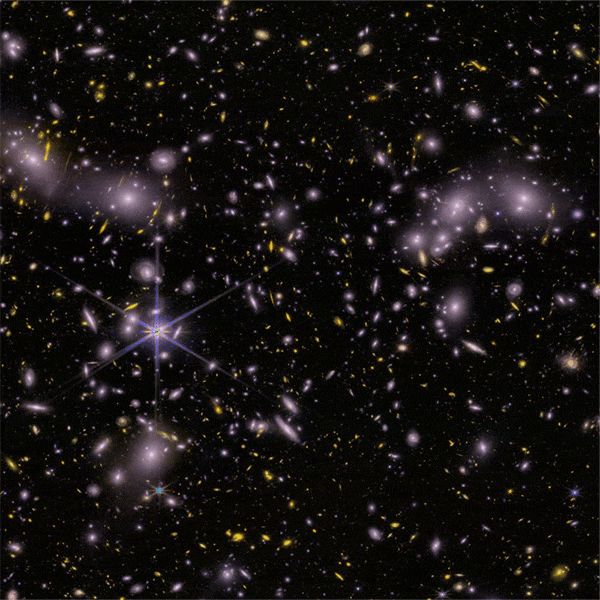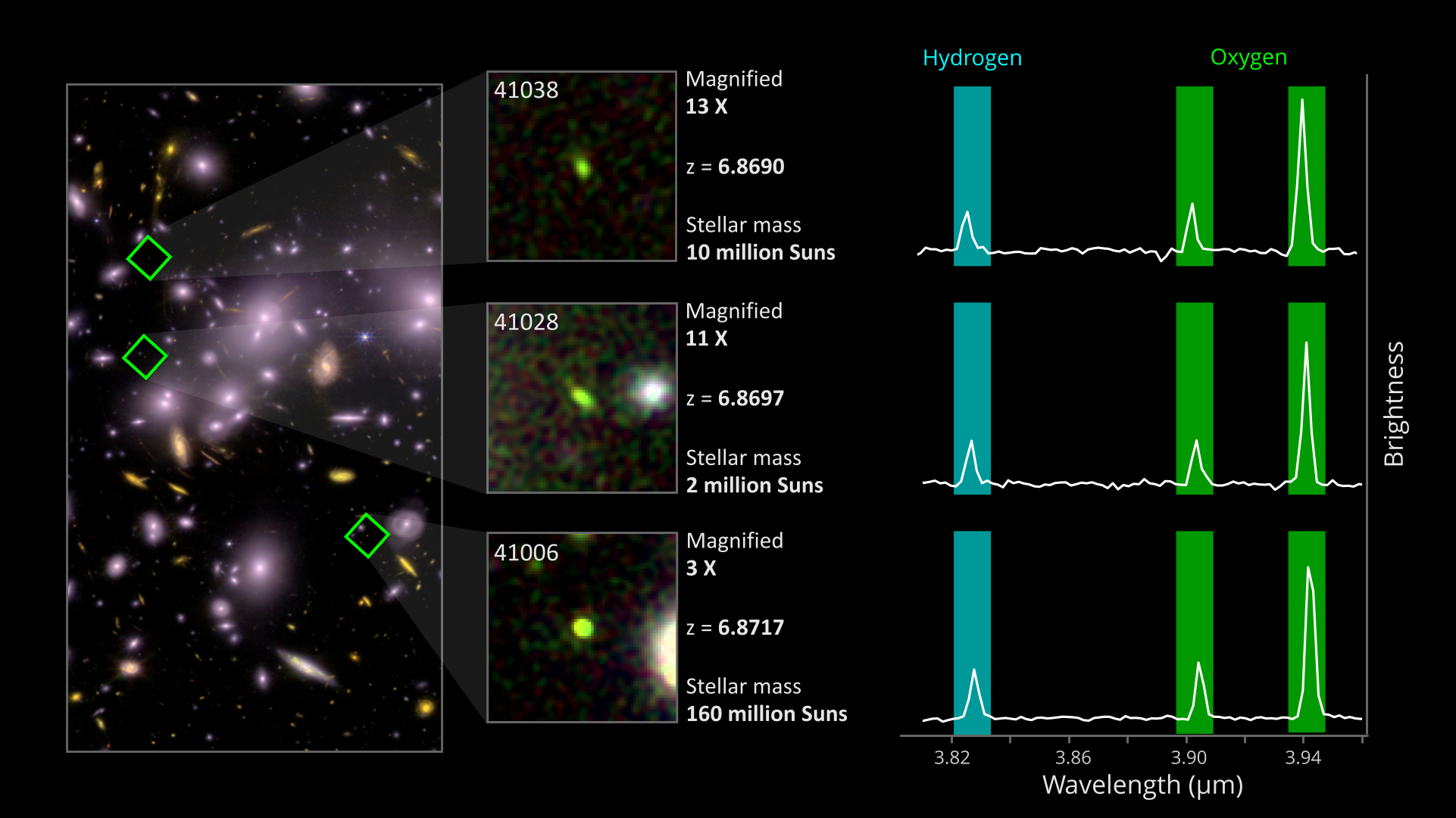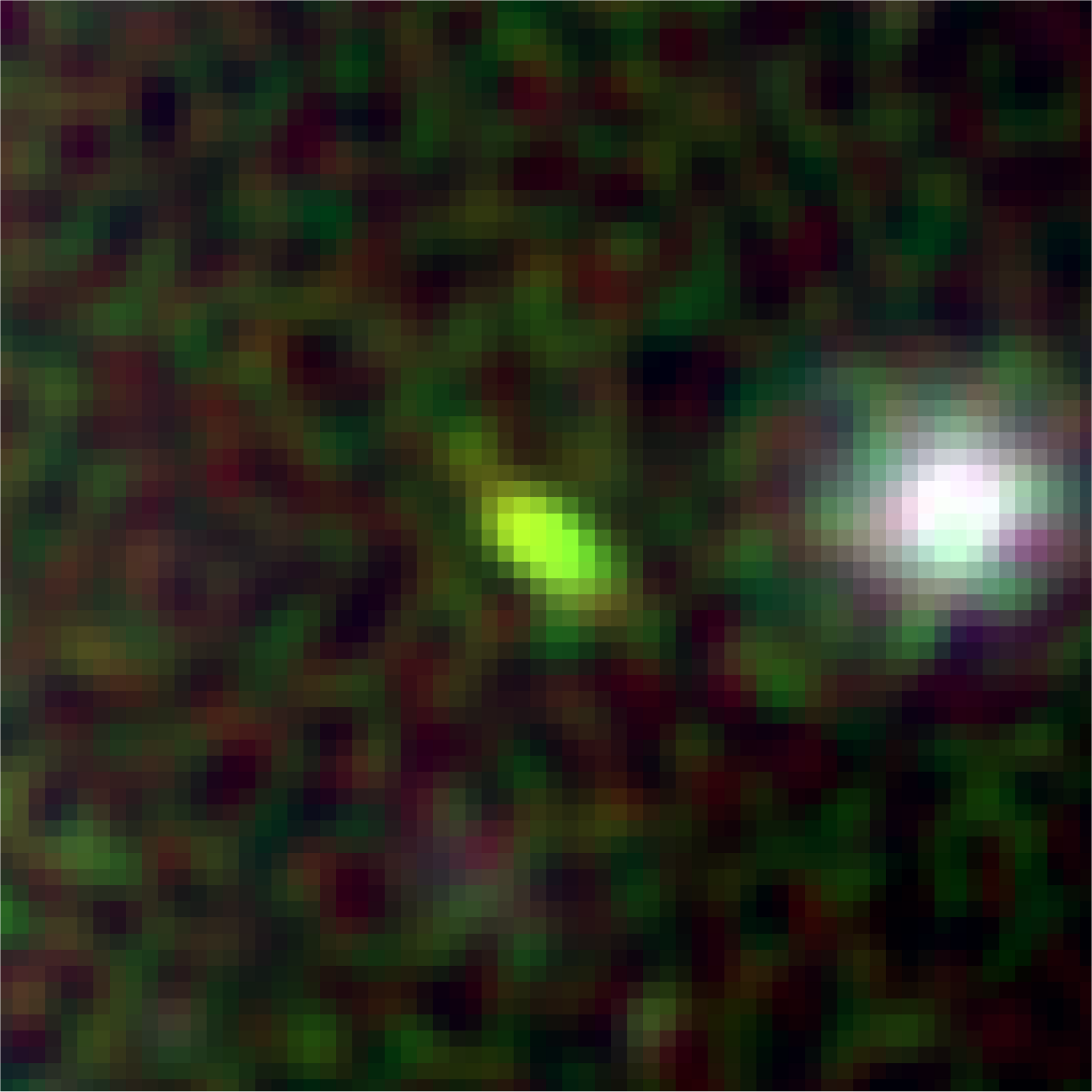"I don't know if the James Webb Space Telescope will ever cover an area of this size again."
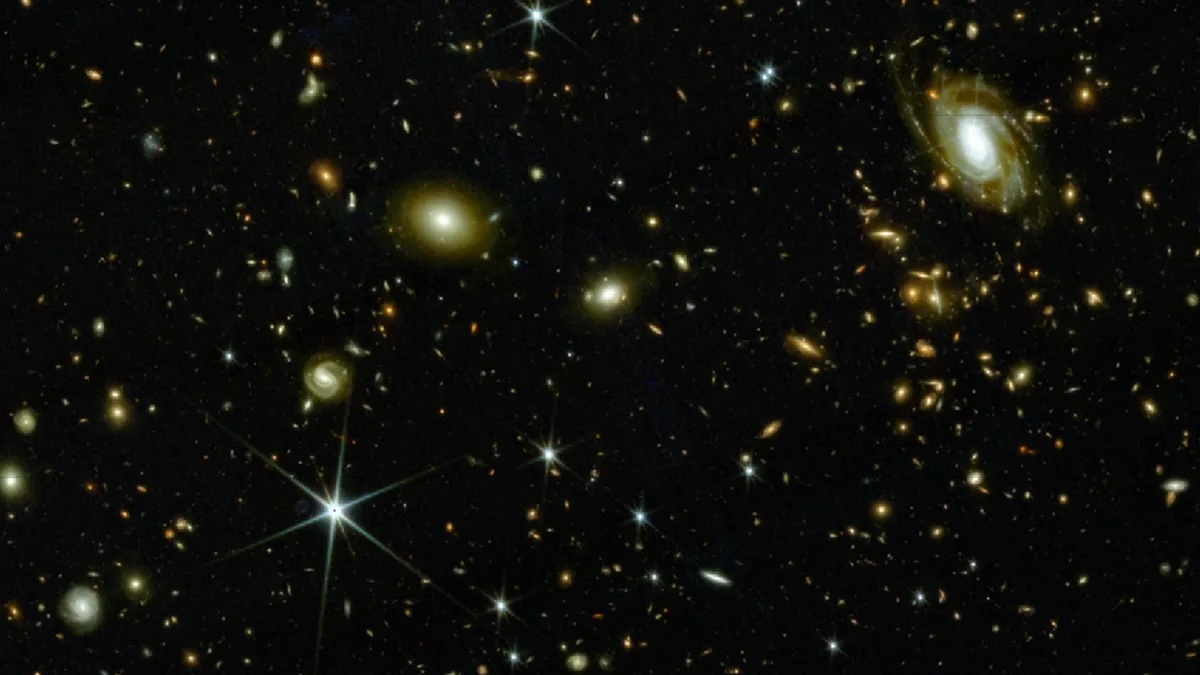
A screenshot of a section of sky in the COSMOS-Web interactive catalog. (Image credit: COSMOS-Web)
Astronomers using the James Webb Space Telescope (JWST) have unveiled the largest map of the early universe to date, a sweeping cosmic panorama that offers seasoned scientists and curious stargazers alike a front-row seat to the ancient cosmos.
The images come from COSMOS-Web, the largest observing program the James Webb Space Telescope undertook in its first year. It surveyed a patch of sky equivalent to the width of three full moons placed side-by-side, the telescope's widest observation area to date. The survey stitched together more than 10,000 exposures, revealing nearly 800,000 galaxies, many of which shine from the universe's earliest eras. Harnessing the abundance of data that came from this effort, on Thursday (June 5), the team released the largest contiguous image ever captured by the JWST, along with a free, interactive catalog detailing the properties of each galaxy — a cosmic record that's as vast as it is richly detailed.
"I don't know if the James Webb Space Telescope will ever cover an area of this size again, and so I think it'll be a good reference and a good data set that people will use for many years," Jeyhan Kartaltepe, an astrophysicist at the Rochester Institute of Technology in New York and the lead researcher of COSMOS-Web, told Space.com. "The hope is that, now, anybody at any institution can make use of this data for their own science."
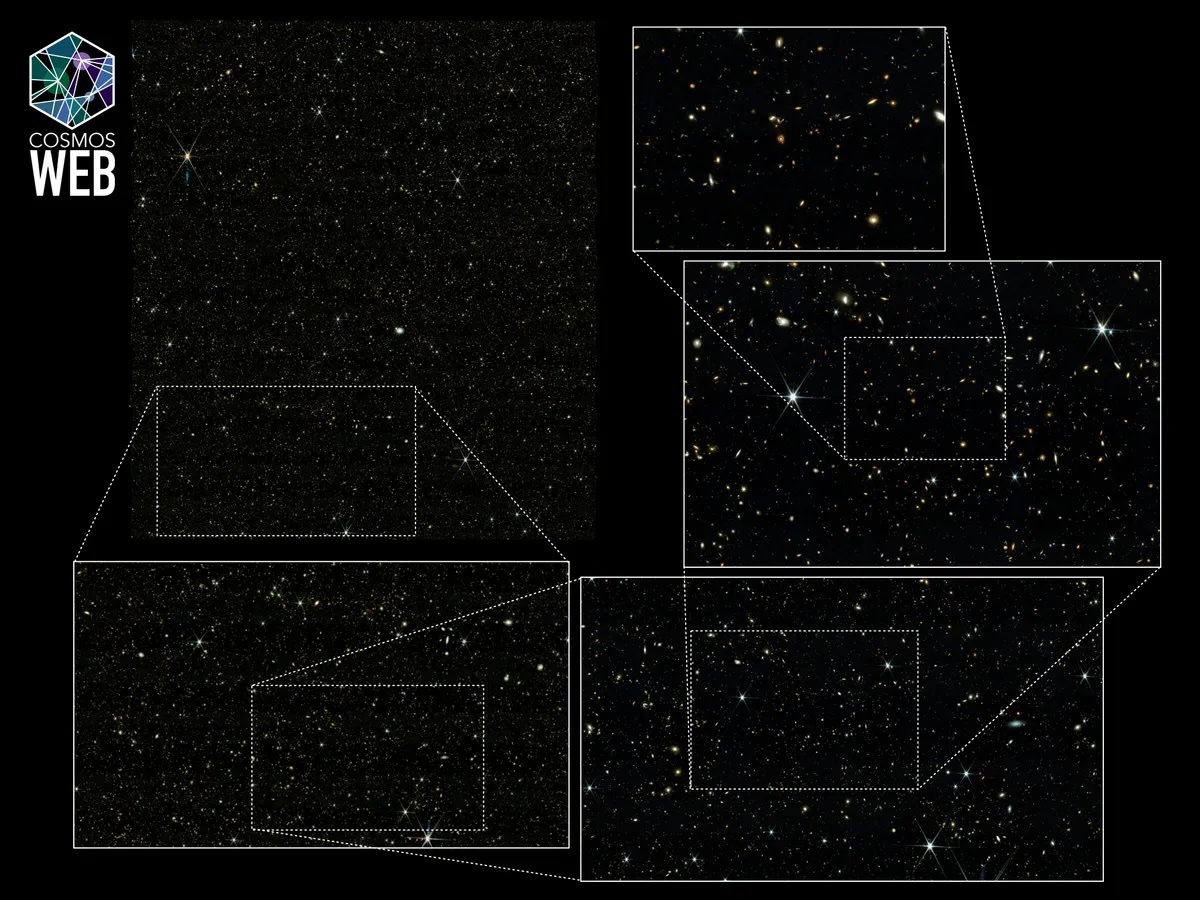
This photo montage from COSMOS-Web shows nine galaxies spanning all of cosmic time, from upper left to lower right: the present-day universe, 3 4, 8, 9, 10, 11, 12, and 13 billion years ago. (Image credit: Kartaltepe, Casey, Franco, and the COSMOS-Web team)
When the JWST launched in 2021, the global COSMOS-Web team comprising nearly 50 researchers from institutions around the world was awarded over 200 hours of observation time, the most allocated to any project in the telescope's inaugural year. While many JWST studies zoom in on small, deep slices of sky, COSMOS-Web prioritized breadth, capturing a wider cosmic canvas that brought to light 10 times more galaxies than astronomers anticipated from these early epochs.
"It was incredible to reveal galaxies that were previously invisible at other wavelengths, and very gratifying to finally see them appear on our computers," Maximilien Franco, postdoctoral researcher of astrophysics at the University of Hertfordshire in the U.K., said in a statement.

A montage of nine galaxies spanning all of cosmic time, from the present day universe (upper left) to 10 billion years ago (lower right). (Image credit: Kartaltepe, Casey, Franco, and the COSMOS-Web team)
The JWST's expansive view allows astronomers not only to catalog distant galaxies, but also to study how their characteristics — including size, shape and brightness — are shaped by their cosmic environments, such as whether they reside in isolation or in crowded regions. "That tells us a lot about what influenced them as they evolved," Kartaltepe said.
Alongside the catalog, the COSMOS-Web team has published a series of scientific papers exploring the data. One study, posted to the preprint archive arXiv on Wednesday (June 4), examines the most luminous galaxies at the centers of galaxy groups, tracing how their structure and star forming activity have co-evolved over the past 12 billion years.
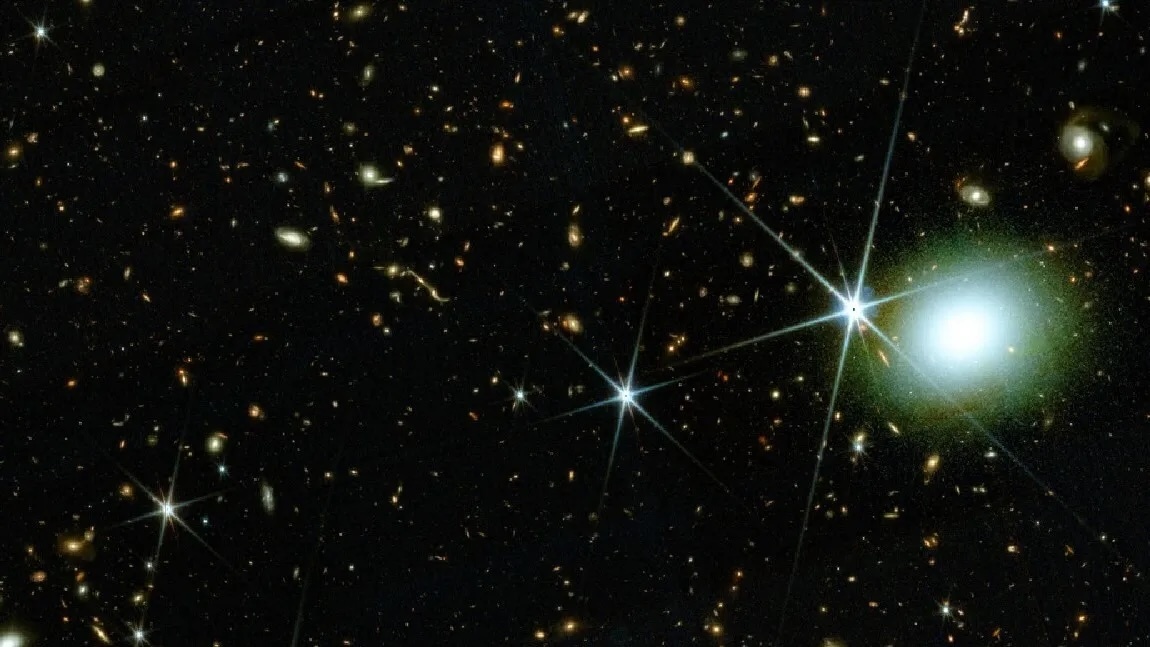
A screenshot of a section of sky in the COSMOS-Web interactive catalog. (Image credit: COSMOS-Web)
A key science goal of the project was to map the earliest structures during the Reionization Era (which fell more than 13 billion years ago) when the first galaxies ignited and began clearing the thick hydrogen fog that blanketed the early cosmos. To achieve this, Kartaltepe and her team plan early galaxies as tracers to measure the size of "reionization bubbles," vast regions where light from stars and galaxies carved clearings in the primordial haze.
"That's not something we finished yet," Kartaltepe said. "But that was the main goal, and something that we're really excited about."
Another paper, which was also posted to arXiv on Wednesday, tests a machine learning technique that can estimate the physical properties of galaxies in the massive dataset. The team also developed a new method to measure the brightness of distant galaxies more accurately. Unlike traditional techniques that simply sum the light within a fixed area, this approach models how light is spread across a galaxy, enabling more precise measurements that allow researchers to combine JWST images with blurrier ground-based data without losing important details.

A screenshot of a section of sky in the COSMOS-Web interactive catalog. (Image credit: COSMOS-Web)
Three more studies detail the team's data processing efforts over the past two years, a meticulous process involving aligning and cleaning more than 10,000 individual images. As a brand-new observatory, the JWST brought unexpected challenges. The telescope's images included unforeseen artifacts, such as noise patterns and distortions, which the team had to carefully correct.
Despite these hurdles, the JWST outperformed pre-launch models predicting how faint or distant galaxies it could detect, said Kartaltepe. "The reality turned out to be better — we were able to go deeper than what we expected."
The catalog holds "incredible potential," she added.
"There's still so much we don't know."
Quelle: SC
----
Update: 12.06.2025
.
Frigid Exoplanet in Strange Orbit Imaged by NASA’s Webb

This image of exoplanet 14 Herculis c was taken by NASA’s James Webb Space Telescope’s NIRCam (Near-Infrared Camera). A star symbol marks the location of the host star 14 Herculis, whose light has been blocked by a coronagraph on NIRCam (shown here as a dark circle outlined in white).
Credits: NASA, ESA, CSA, STScI, W. Balmer (JHU), D. Bardalez Gagliuffi (Amherst College)
A planetary system described as abnormal, chaotic, and strange by researchers has come into clearer view with NASA’s James Webb Space Telescope. Using Webb’s NIRCam (Near-Infrared Camera), researchers have successfully imaged one of two known planets surrounding the star 14 Herculis, located 60 light-years away from Earth in our own Milky Way galaxy.
The exoplanet, 14 Herculis c, is one of the coldest imaged to date. While there are nearly 6,000 exoplanets that have been discovered, only a small number of those have been directly imaged, most of those being very hot (think hundreds or even thousands of degrees Fahrenheit). The new data suggests 14 Herculis c, which weighs about 7 times the planet Jupiter, is as cool as 26 degrees Fahrenheit (minus 3 degrees Celsius).
The team’s results covering 14 Herculis c have been accepted for publication in The Astrophysical Journal Letters and were presented in a press conference Tuesday at the 246th meeting of the American Astronomical Society in Anchorage, Alaska.
“The colder an exoplanet, the harder it is to image, so this is a totally new regime of study that Webb has unlocked with its extreme sensitivity in the infrared,” said William Balmer, co-first author of the new paper and graduate student at Johns Hopkins University. “We are now able to add to the catalog of not just hot, young exoplanets imaged, but older exoplanets that are far colder than we’ve directly seen before Webb.”
Webb’s image of 14 Herculis c also provides insights into a planetary system unlike most others studied in detail with Webb and other ground- and space-based `observatories. The central star, 14 Herculis, is almost Sun-like – it is similar in age and temperature to our own Sun, but a little less massive and cooler.
There are two planets in this system – 14 Herculis b is closer to the star, and covered by the coronagraphic mask in the Webb image. These planets don’t orbit the host star on the same plane like our solar system. Instead, they cross each other like an ‘X’, with the star being at the center. That is, the orbital planes of the two planets are inclined relative to one another at an angle of about 40 degrees. The planets tug and pull at one another as they orbit the star.
This is the first time an image has ever been snapped of an exoplanet in such a mis-aligned system.
Scientists are working on several theories for just how the planets in this system got so “off track.” One of the leading concepts is that the planets scattered after a third planet was violently ejected from the system early in its formation.
“The early evolution of our own solar system was dominated by the movement and pull of our own gas giants,” added Balmer. “They threw around asteroids and rearranged other planets. Here, we are seeing the aftermath of a more violent planetary crime scene. It reminds us that something similar could have happened to our own solar system, and that the outcomes for small planets like Earth are often dictated by much larger forces.”
Webb’s new data is giving researchers further insights into not just the temperature of 14 Herculis c, but other details about the planet’s orbit and atmosphere.
Findings indicate the planet orbits around 1.4 billion miles from the host star in a highly elliptical, or football-shaped orbit, closer in than previous estimates. This is around 15 times farther from the Sun than Earth. On average, this would put 14 Herculis c between Saturn and Uranus in our solar system.
The planet’s brightness at 4.4 microns measured using Webb’s coronagraph, combined with the known mass of the planet and age of the system, hints at some complex atmospheric dynamics at play.
“If a planet of a certain mass formed 4 billion years ago, then cooled over time because it doesn't have a source of energy keeping it warm, we can predict how hot it should be today,” said Daniella C. Bardalez Gagliuffi of Amherst College, co-first author on the paper with Balmer. “Added information, like the perceived brightness in direct imaging, would in theory support this estimate of the planet’s temperature.”
However, what researchers expect isn’t always reflected in the results. With 14 Herculis c, the brightness at this wavelength is fainter than expected for an object of this mass and age. The research team can explain this discrepancy, though. It’s called carbon disequilibrium chemistry, something often seen in brown dwarfs.
“This exoplanet is so cold, the best comparisons we have that are well-studied are the coldest brown dwarfs,” Bardalez Gagliuffi explained. “In those objects, like with 14 Herculis c, we see carbon dioxide and carbon monoxide existing at temperatures where we should see methane. This is explained by churning in the atmosphere. Molecules made at warmer temperatures in the lower atmosphere are brought to the cold, upper atmosphere very quickly.”
Researchers hope Webb’s image of 14 Herculis c is just the beginning of a new phase of investigation into this strange system.
While the small dot of light obtained by Webb contains a plethora of information, future spectroscopic studies of 14 Herculis could better constrain the atmospheric properties of this interesting planet and help researchers understand the dynamics and formation pathways of the system.
The James Webb Space Telescope is the world’s premier space science observatory. Webb is solving mysteries in our solar system, looking beyond to distant worlds around other stars, and probing the mysterious structures and origins of our universe and our place in it. Webb is an international program led by NASA with its partners, ESA (European Space Agency) and CSA (Canadian Space Agency).
Quelle: NASA
----
Update: 13.06.2025
.
NASA’s Webb ‘UNCOVERs’ Galaxy Population Driving Cosmic Renovation
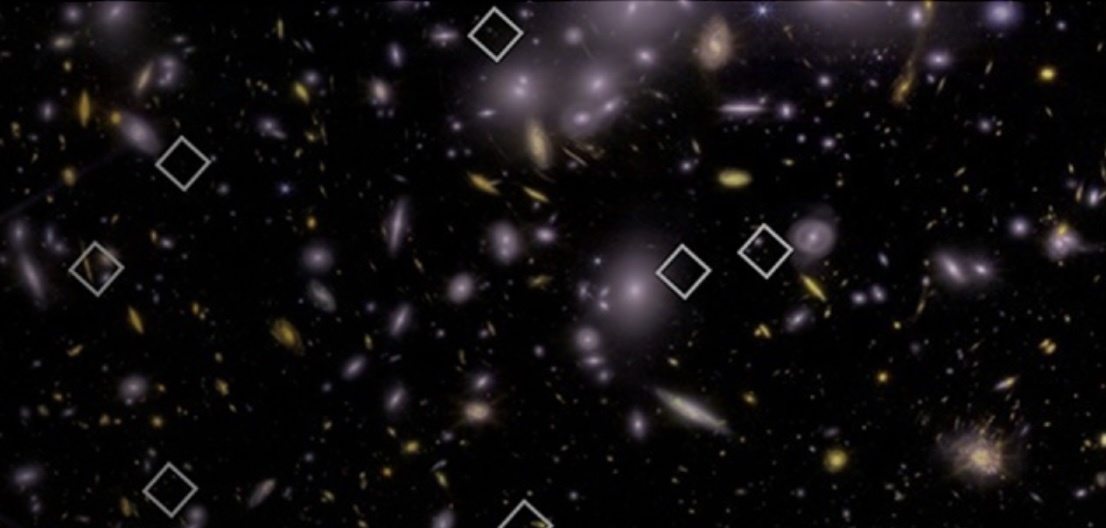
White diamonds show the locations of 20 of the 83 young, low-mass, starburst galaxies found in infrared images of the giant galaxy cluster Abell 2744. Full image and description shown below.
Credits: NASA/ESA/CSA/Bezanson et al. 2024 and Wold et al. 2025
Astronomers using data from NASA’s James Webb Space Telescope have identified dozens of small galaxies that played a starring role in a cosmic makeover that transformed the early universe into the one we know today.
“When it comes to producing ultraviolet light, these small galaxies punch well above their weight,” said Isak Wold, an assistant research scientist at Catholic University of America in Washington and NASA’s Goddard Space Flight Center in Greenbelt, Maryland. “Our analysis of these tiny but mighty galaxies is 10 times more sensitive than previous studies, and shows they existed in sufficient numbers and packed enough ultraviolet power to drive this cosmic renovation.”
Wold discussed his findings Wednesday at the 246th meeting of the American Astronomical Society in Anchorage, Alaska. The study took advantage of existing imaging collected by Webb’s NIRCam (Near-Infrared Camera) instrument, as well as new observations made with its NIRSpec (Near-Infrared Spectrograph) instrument.
The tiny galaxies were discovered by Wold and his Goddard colleagues, Sangeeta Malhotra and James Rhoads, by sifting through Webb images captured as part of the UNCOVER (Ultradeep NIRSpec and NIRCam ObserVations before the Epoch of Reionization) observing program, led by Rachel Bezanson at the University of Pittsburgh in Pennsylvania.
The project mapped a giant galaxy cluster known as Abell 2744, nicknamed Pandora’s cluster, located about 4 billion light-years away in the southern constellation Sculptor. The cluster’s mass forms a gravitational lens that magnifies distant sources, adding to Webb’s already considerable reach.
For much of its first billion years, the universe was immersed in a fog of neutral hydrogen gas. Today, this gas is ionized — stripped of its electrons. Astronomers, who refer to this transformation as reionization, have long wondered which types of objects were most responsible: big galaxies, small galaxies, or supermassive black holes in active galaxies. As one of its main goals, NASA’s Webb was specifically designed to address key questions about this major transition in the history of the universe.
Recent studies have shown that small galaxies undergoing vigorous star formation could have played an outsized role. Such galaxies are rare today, making up only about 1% of those around us. But they were abundant when the universe was about 800 million years old, an epoch astronomers refer to as redshift 7, when reionization was well underway.
The team searched for small galaxies of the right cosmic age that showed signs of extreme star formation, called starbursts, in NIRCam images of the cluster.
“Low-mass galaxies gather less neutral hydrogen gas around them, which makes it easier for ionizing ultraviolet light to escape,” Rhoads said. “Likewise, starburst episodes not only produce plentiful ultraviolet light — they also carve channels into a galaxy’s interstellar matter that helps this light break out.”
The astronomers looked for strong sources of a specific wavelength of light that signifies the presence of high-energy processes: a green line emitted by oxygen atoms that have lost two electrons. Originally emitted as visible light in the early cosmos, the green glow from doubly ionized oxygen was stretched into the infrared as it traversed the expanding universe and eventually reached Webb’s instruments.
This technique revealed 83 small starburst galaxies as they appear when the universe was 800 million years old, or about 6% of its current age of 13.8 billion years. The team selected 20 of these for deeper inspection using NIRSpec.
“These galaxies are so small that, to build the equivalent stellar mass of our own Milky Way galaxy, you’d need from 2,000 to 200,000 of them,” Malhotra said. “But we are able to detect them because of our novel sample selection technique combined with gravitational lensing.”
Similar types of galaxies in the present-day universe, such as green peas, release about 25% of their ionizing ultraviolet light into surrounding space. If the low-mass starburst galaxies explored by Wold and his team release a similar amount, they can account for all of the ultraviolet light needed to convert the universe’s neutral hydrogen to its ionized form.
The James Webb Space Telescope is the world's premier space science observatory. Webb is solving mysteries in our solar system, looking beyond to distant worlds around other stars, and probing the mysterious structures and origins of our universe and our place in it. Webb is an international program led by NASA with its partners, ESA (European Space Agency) and CSA (Canadian Space Agency).
Quelle: NASA
----
Update: 27.06.2025
.
The James Webb Space Telescope has discovered its 1st exoplanet and snapped its picture (image)
The new planet TWA 7b is also the lightest exoplanet ever to be directly imaged.
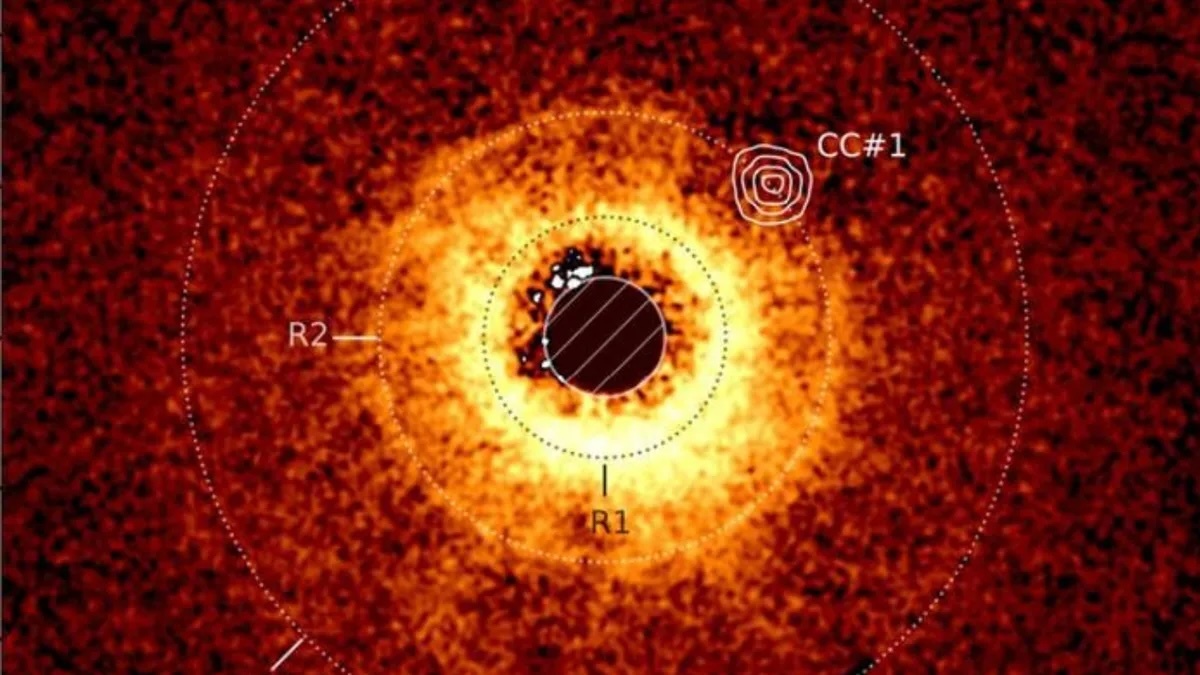
Image of the disk around the star TWA 7 recorded using ESO's Very Large Telescope's SPHERE instrument. The image captured with JWST’s MIRI instrument is overlayed. We can clearly see the empty area around TWA 7 B in the R2 ring (CC #1). (Image credit: A.-M. Lagrange and al. - Evidence for a sub-Jovian planet in the young TWA7 disk, 2025)
After three years of helping astronomers investigate known planets beyond the solar system, the James Webb Space Telescope (JWST) has discovered its first new planet.
The extrasolar planet, or "exoplanet," which has been designated TWA 7b, also happens to have the lowest mass of any planet that has been directly imaged beyond the solar system. With an estimated mass of around 100 times that of Earth or 0.3 times the mass of Jupiter, TWA 7b is ten times lighter than any exoplanet previously directly imaged.
TWA 7b was discovered in the debris rings that surround the low-mass star CE Antilae, also known as TWA 7, located around 111 light-years from Earth. CE Antilae is a very young star, estimated to be around just a few million years old. If that seems ancient, consider the sun, a "middle-aged" star, is around 4.6 billion years old.
CE Antilae, discovered in 1999, has long been a system of great interest to astronomers because it is seen "pole-on" from Earth. That means the disk of debris or "protoplanetary disk" that surrounds CE Antliae is seen 'from above' (or 'below'), revealing its full extent.
This has allowed astronomers to see structures in this disk that appear to have been created by the gravity of then-unseen planets and planetesimals, the "seeds" which gather mass to grow into full planets.
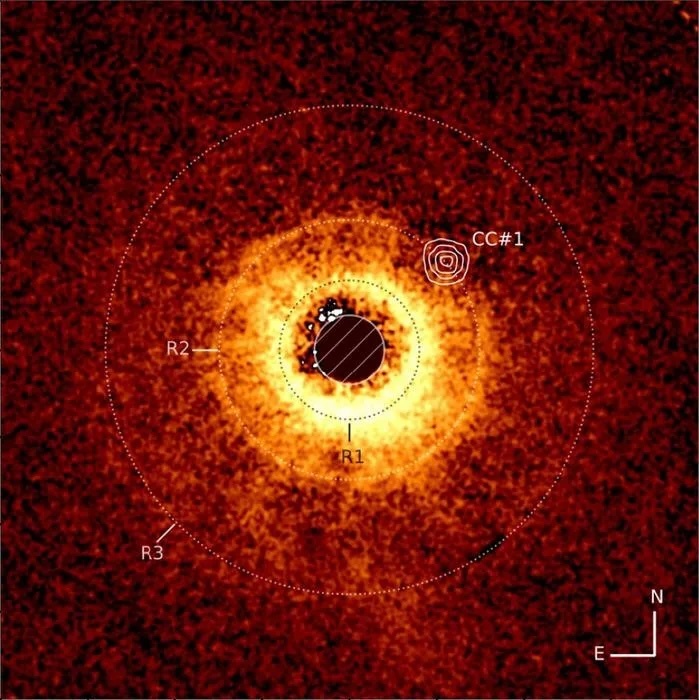
Full sized image of the JWST's observations of the star CE Antliae and its exoplanet TWA 7b. (Image credit: A.-M. Lagrange and al. - Evidence for a sub-jovian planet in the young TWA7 disk, 2025)
The disk of CE Antilae is divided into three distinct rings, one of which is narrow and bounded by two empty "lanes" mostly devoid of matter.
When imaging this ring, the JWST spotted an infrared-emitting source, which the team of astronomers determined is most likely a young exoplanet. They then used simulations that confirmed the formation of a thin ring and a "hole" exactly where this planet is positioned, corresponding to JWST observations.
The JWST is the ideal instrument to detect young low-mass planets like TWA 7b, which emit infrared radiation, the type of light the $10 billion space telescope is most sensitive to.
Directly imaging these planets is difficult because they are drowned out by light from their parent stars. The JWST is equipped with a coronagraph that blocks out the light from central stars, allowing the faint infrared emissions of orbiting exoplanets to be detected by its Mid-Infrared Instrument (MIRI).
That means, though this is the lowest mass planet ever imaged and the first exoplanet discovered by the JWST, it's a safe bet that the powerful space telescope will discover many more planets as it images even lighter worlds.
The team's research was published in the journal Nature.
Quelle: SC
----
Update: 29.06.2025
.
JAMES WEBB SPACE TELESCOPE DISCOVERS ITS FIRST PLANET
The Saturn-mass planet candidate is probably newly formed and orbits a young star that’s only 6.4 million years old.

In this image combining ground-based data from ESO’s Very Large Telescope (VLT) and data from Webb’s MIRI (Mid-Infrared Instrument), light from the star TWA 7 has been subtracted. The location of the star is marked with a circle and a star symbol at the center of the image. The blue color represents data from the VLT’s SPHERE instrument, which showcases the location of the disk surrounding the host star. MIRI data is shown in orange. The bright orange spot to the upper right of the star is the source identified as TWA 7 b, within the debris disk.
NASA / ESA / CSA / Anne-Marie Lagrange (CNRS, UGA) / Mahdi Zamani (ESA / Webb)
Astronomers using NASA’s James Webb Space Telescope have directly imaged what appears to be a Saturn-mass exoplanet, marking Webb’s first direct detection of a planet outside our solar system. If confirmed, it would be the lightest planet ever photographed in this way.
The planet candidate, TWA 7b, orbits a young red dwarf star (known as a T Tauri star) located around 111 light-years away in the southern constellation Antlia. At just 6.4 million years old, the star is still encircled by a sprawling debris disk — a remnant of its formation. Using Webb’s Mid-Infrared Instrument (MIRI), a team led by Anne-Marie Lagrange (Paris Observatory) detected a faint infrared source nestled within one of three concentric dust rings. (The rings had previously been seen with ground-based telescopes.)
After ruling out more mundane explanations, including a foreground interloper in our own solar system, the team concluded that the object is almost certainly local to the TWA 7 system. “Our observations reveal a strong candidate for a planet shaping the structure of the TWA 7 debris disk, and its position is exactly where we expected to find a planet of this mass,” Lagrange says. She and her team published the result in Nature.
TWA 7’s combination of youth, orientation and relative proximity made it a prime target for Webb’s infrared capabilities. “[This discovery] represents an exciting step forward in our understanding of planetary systems, including our own,” says team member Mathilde Malin (Johns Hopkins University).
Imaging a planet directly is technically demanding. Most exoplanets are found indirectly, by their effects on their host stars. Directly imaging planets requires isolating their dim glow from the overwhelming glare of its sun. To date, nearly all such images have involved massive, hot planets several times the mass of Jupiter. Spotting a Saturn-mass object like TWA 7 b represents a big step forward.
TWA 7 b appears to orbit roughly 50 astronomical units from its star — more than five times farther out than Saturn is from the Sun. That would usually mean the planet is cold but, because the system is so young, the planet still radiates heat from its formation. Lagrange's team concluded that its temperature is a balmy 47°C (117°F), still markedly cooler than previous directly imaged planets.
“This is a hugely important discovery,” says Beth Biller (University of Edinburgh, UK), who was not involved in the research. “I think TWA 7b is going to be amazing for opening up a new realm of cool exoplanet atmospheres to characterize.” Among other things, direct imaging allows astronomers to glimpse a planet’s atmospheric molecules, clouds, and weather.
The discovery hints at more than just the planet itself. Its location within the debris disk suggests it may be shaping the structure of the surrounding material. If confirmed, it would mark the first time a directly imaged planet has been linked to the sculpting of a debris disk.
Intriguingly, Webb may have also picked up evidence of “Trojan” dust — material that’s clustered around stable points both ahead of and behind the planet in its orbit. These zones mirror the way Trojan asteroids share orbits with planets in our own solar system, most notably Jupiter.
Quelle: Sky&Telescope
----
Update: 12.07.2025
.
Webb scratches under Cat’s Paw Nebula for third anniversary
To mark its third year of highly productive science, astronomers used the NASA/ESA/CSA James Webb Space Telescope to scratch beyond the surface of the Cat’s Paw Nebula (NGC 6334), a massive, local star-forming region.
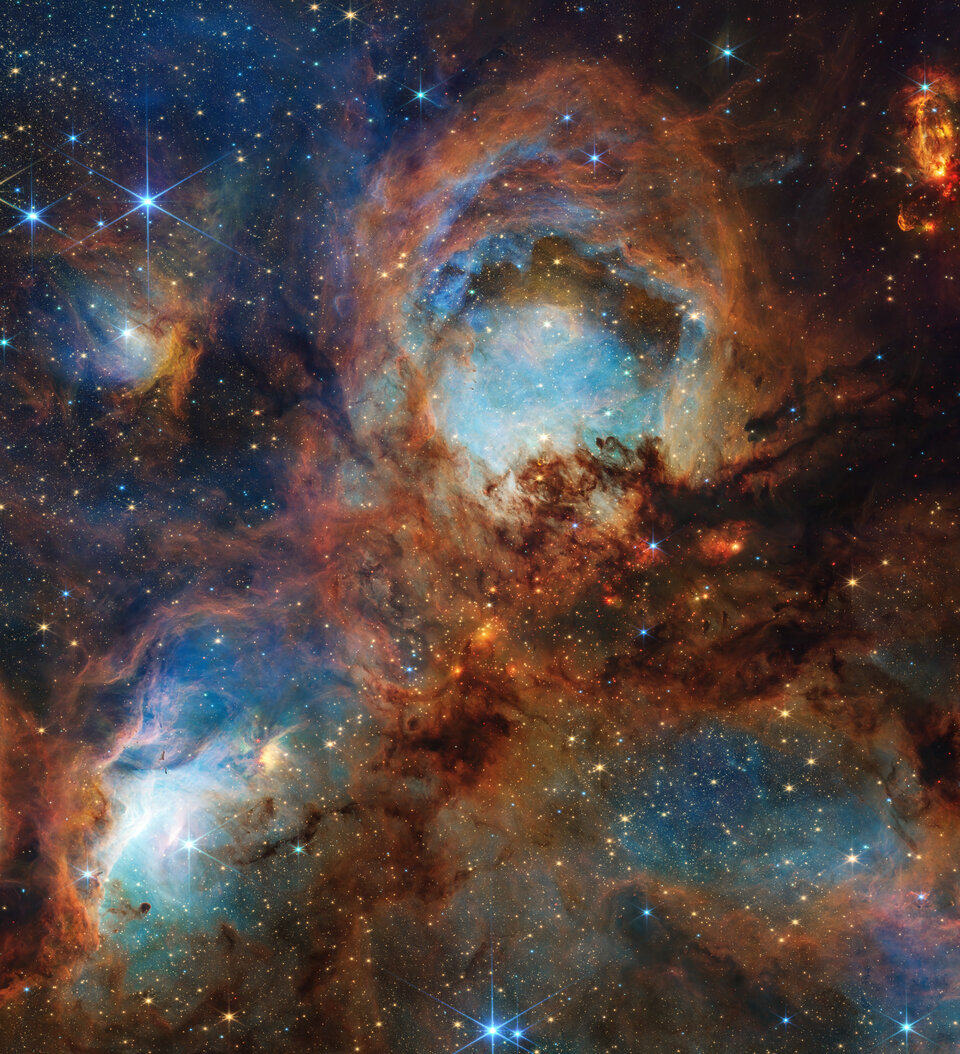
Webb’s NIRCam instrument was used to look at this particular area of the Cat’s Paw Nebula, which just scratches the surface of the telescope’s three years of groundbreaking science.
A star formation flex
The progression from a large molecular cloud to massive stars entails multiple steps, some of which are still not well understood by astronomers. Located approximately 4000 light-years away in the constellation Scorpius, the Cat’s Paw Nebula offers scientists the opportunity to study the turbulent cloud-to-star process in great detail. Webb’s observation of the nebula in near-infrared light builds upon previous studies by the NASA/ESA Hubble and retired NASA Spitzer Space Telescopes in visible and infrared light, respectively.
With its sharp resolution, Webb shows never-before-seen structural details and features: Massive young stars are carving away at nearby gas and dust, while their bright starlight is producing a bright nebulous glow represented in blue. It’s a temporary scene where the disruptive young stars, with their relatively short lifespans and luminosity, have a brief but important role in the region’s larger story. As a consequence of these massive stars’ lively behavior, the local star formation process will eventually come to a stop.
The opera house’s intricate structure
Start with the region at top centre, which is nicknamed the 'Opera House' for its circular, tiered-like structure. The primary drivers for the area’s cloudy blue glow are most likely toward its bottom: either the light from the bright yellowish stars or from a nearby source still hidden behind the dense, dark brown dust.
Just below the orange-brown tiers of dust is a bright yellow star with diffraction spikes. While this massive star has carved away at its immediate surroundings, it has been unable to push the gas and dust away to greater distances, creating a compact shell of surrounding material.
Look closely to notice small patches, like the tuning fork-shaped area to the Opera House’s immediate left, that contain fewer stars. These seemingly vacant zones indicate the presence of dense foreground filaments of dust that are home to still-forming stars and block the light of stars in the background.
A spotlight on stars
Toward the image’s centre are small, fiery red clumps scattered amongst the brown dust. These glowing red sources mark regions where massive star formation is underway, albeit in an obscured manner.
Some massive blue-white stars, like the one in the lower left region, seem to be more sharply resolved than others. This is because any intervening material between the star and the telescope has been dissipated by stellar radiation.
Near the bottom of this region are small, dense filaments of dust. These tiny clumps of dust have managed to remain despite the intense radiation, suggesting that they are dense enough to form protostars. A small section of yellow at the right notes the location of a still-enshrouded massive star that has managed to shine through intervening material.
Across this entire scene are many small yellow stars with diffraction spikes. Bright blue-white stars are in the foreground of this Webb image, but some may be a part of the more expansive Cat’s Paw Nebula area.
One eye-catching aspect of this Webb image is the bright, red-orange oval at top right. Its low count of background stars implies it is a dense area just beginning its star-formation process. A couple of visible and still-veiled stars are scattered throughout this region, which are contributing to the illumination of the material in the middle. Some still-enveloped stars leave hints of their presence, like a bow shock at the bottom left, which indicates an energetic ejection of gas and dust from a bright source.
Another incredible year of science and images
Webb continued to return on its ambitious science goals over its third year of operations. Unexpected, bright hydrogen emission was found in the galaxy GZ-z13-1, a mere 330 million years after the Big Bang. Showcasing its coronagraph, Webb took direct images of exoplanets in the HR 8799 system which revealed how they likely formed. Then, astronomers discovered a potential new exoplanet in the debris disc around star TWA 7, the first such discovery made with Webb’s coronagraph – but surely not the last. Closer to home, astronomers were able to watch aurorae unfold over a period of just hours on Jupiter.
A remarkable view of a rare Einstein ring, a rich collection of galaxies that acts as a lens on the distant past, a protoplanetary disc sporting powerful stellar winds, and the Sombrero Galaxy seen in an entirely new light were just some of the images released over the past year through which Webb showed us a new view of the cosmos.
In a particular highlight from Webb, the first discovery of young brown dwarf stars outside our galaxy produced a truly breathtaking image of star cluster NGC 602, a vista of its many colours of ionised gas.
More information
Webb is the largest, most powerful telescope ever launched into space. Under an international collaboration agreement, ESA provided the telescope’s launch service, using the Ariane 5 launch vehicle. Working with partners, ESA was responsible for the development and qualification of Ariane 5 adaptations for the Webb mission and for the procurement of the launch service by Arianespace. ESA also provided the workhorse spectrograph NIRSpec and 50% of the mid-infrared instrument MIRI, which was designed and built by a consortium of nationally funded European Institutes (The MIRI European Consortium) in partnership with JPL and the University of Arizona.
Quelle: ESA








